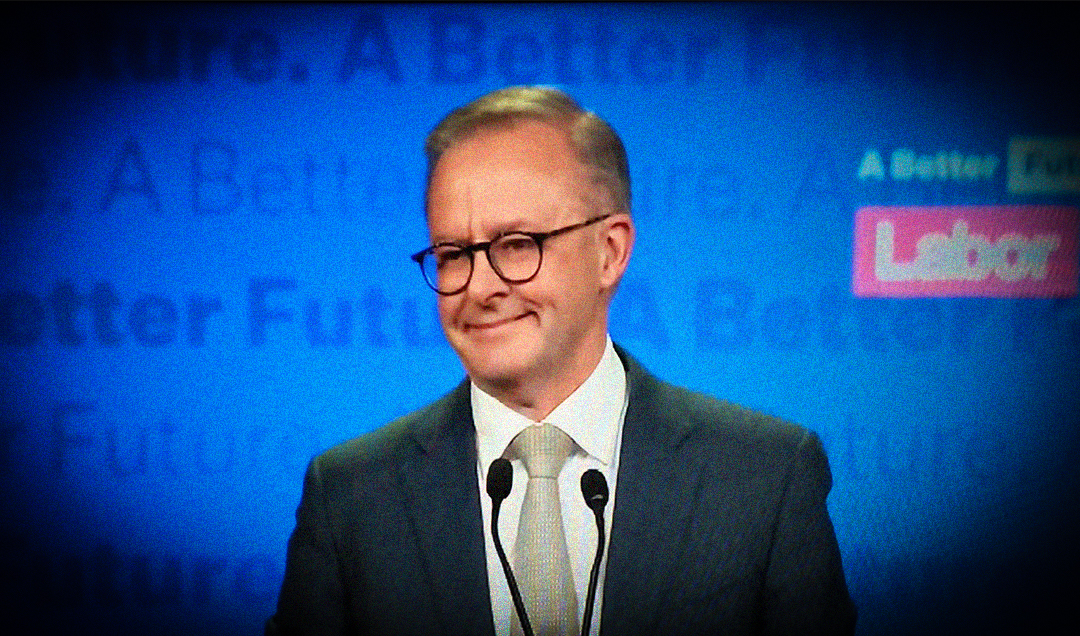The Australian federal election has ended the reign of one of the most despised national governments the country has endured since WWII. Against a backdrop of the skyrocketing cost of living, a housing crisis, general economic malaise and intensifying concerns regarding climate change, the Scott Morrison-led (conservative) Liberal-National Coalition has been tossed aside by a population that is feeling the brunt of intensifying tumult.
Although at the time of writing, the count is still unfinished, it’s been projected that the Australian Labor Party (ALP) should win an outright majority of 78 of 150 seats in parliament, surpassing the magic number of 76 and allowing it to form a majority government without support from other parties or Independents.
“I don’t hold a hose, mate!”
After unexpectedly winning the election in 2019, the subsequent two-and-a-half years saw the Coalition government stumble from one ignominious failure to the next.
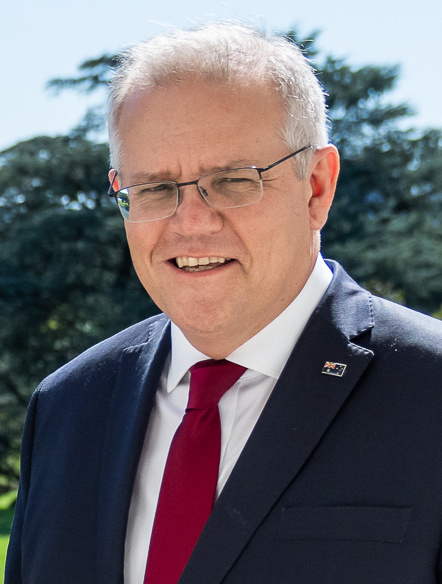 The Scott Morrison-led Liberal-National Coalition has been tossed aside at the last elections by a population that is feeling the brunt of intensifying tumult / Image: public domain
The Scott Morrison-led Liberal-National Coalition has been tossed aside at the last elections by a population that is feeling the brunt of intensifying tumult / Image: public domain
Roll back to December 2019, and the Eastern seaboard of Australia was ablaze with some of the worst bushfires this continent has ever experienced. This didn’t stop Prime Minister Morrison from jetting for a holiday in Hawaii on 16 December, since known infamously as ‘Abscondment Day’.
As one town after another succumbed to the raging fires, Morrison denied he had ever left the country. However, it didn’t take long for pictures of the PM living it up on Waikiki beach to emerge, forcing him to admit he had indeed left the country. Even the normally pro-Liberal sycophants from the billionaire-owned media joined in the criticism, to which Morrison infamously retorted during a radio interview; “I don’t hold a hose, mate!”
The bungled COVID response
After the implementation of the COVID-19 lockdowns, $A130 billion dollars was shifted into the coffers of business under the guise of the so-called ‘JobKeeper’ stimulus package, even though they knew, and later acknowledged, that as a conservative estimate $A27 billion dollars went to businesses that didn’t even need it. One noted example was the subsidy given to Australia’s largest retailer, Harvey Norman, to the tune of $A22 million. After it was announced the Harvey Norman group had made a bumper profit before tax of $A1.183 billion, the resulting furore led them to repay just $6 million of the public money they received.
Since the bushfires put the Morrison government severely on the back foot, and flowing to an extent from the influence of similar international measures, the state governments were obliged to implement strict lockdown measures to control the spread of COVID. However, since there was no coherent strategy at the national level, this meant the states proceeded alone in developing their own separate policies. This led to the fiasco of one outbreak inevitably spreading into another state, and the country nearly returning to pre-Federation border controls.
The Morrison government then bungled the ordering of vital vaccine supplies, which meant lockdowns in the states dragged on for significantly longer than necessary due to the delays in vaccinating the population. During this time, they were even politicking against the (relatively popular) state lockdowns based on the effect they were having on the economy and overall business profitability, the only thing the government professed any concern for.
By failing to order an adequate supply of rapid antigen tests (despite extensive expert advice forewarning the government), and refusing to make the tests free and widely available with the regular PCR testing system buckling under the strain, another wave of infections followed with the Omicron strain. However, there was undoubtedly a mood of ‘lockdown fatigue’, which assisted the various state and federal governments who wished to ram through the “let it rip” strategy and “live with the virus”. Paradoxically, the extended lockdown resulted from the Morrison government’s own mismanagement of the vaccine rollout.
Lockdown policies lead to strike action
The ‘let it rip’ laissez-faire policy regarding COVID had one particular impact that is causing concern within the circles of the ruling class. The focus of the National Coalition government, once it regrouped from the initial COVID wave, has been to ensure that business interests override any concerns regarding public health. As a consequence, during the Omicron wave, Australia had among the highest rates of infection and subsequent hospitalisations, per capita, in the world. Fortunately, near universal vaccination rates (over 90 percent) mitigated the number of ICU admissions and deaths, but the hospital system was still stretched to breaking point, with the burden falling on hospital nursing staff to manage the crisis.
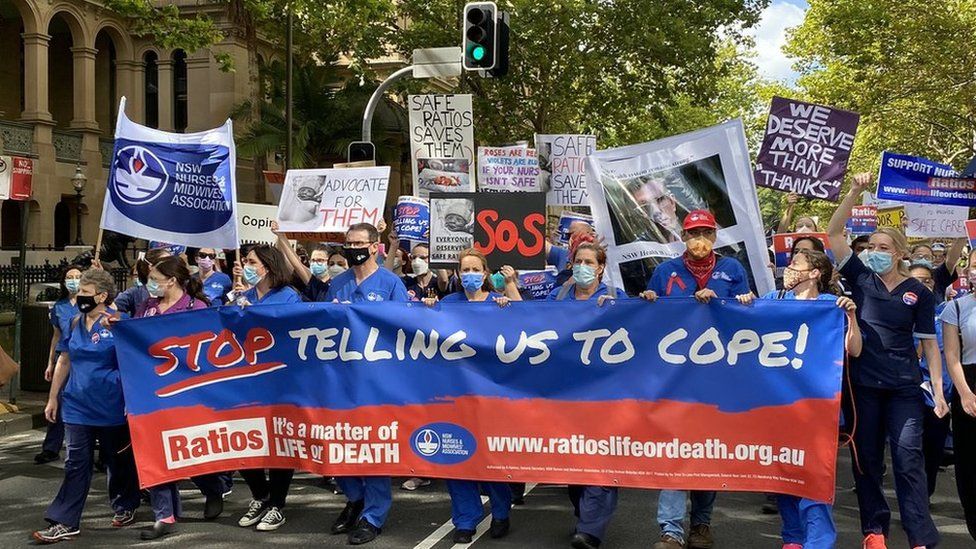 Pressure from below broke through with the organisation of the first statewide nurses’ strike in a decade / Image: Australian Nursing Midwifery Federation
Pressure from below broke through with the organisation of the first statewide nurses’ strike in a decade / Image: Australian Nursing Midwifery Federation
This led to a severe strain on the already underfunded public health system in New South Wales, which also under Liberal governance slavishly followed the ‘let it rip’ strategy. Shifting all responsibility onto the backs of nursing staff to manage the crisis has led to considerable stress, burnout, and plummeting morale.
At some point, this had to have an effect, and the pressure from below broke through with the organisation of the first statewide nurses’ strike in a decade. Immediately, the ruling class responded by dragging the unions through the courts to have the strike declared “illegal”. Although the union was ordered to stop organising the strike, it proceeded in defiance of the court order. This was followed up with another strike some weeks later.
Ordinarily, demonising the striking workers would be the standard strategy employed by the state and billionaire-owned media, but the heroic actions throughout the entire Covid pandemic blunted any coverage along these lines. Even the normally vicious Murdoch press was muted by the defiance of the court order and the general support among the population for the striking workers. This will set an example to other industrial sectors and already the Rail, Tram and Bus Union of NSW has moved to take industrial action despite the NSW transport minister accusing the union of “terrorist-like activity”.
Crisis in the federal Coalition
Once the country emerged from the Covid fiasco of the past 2 years, Scott Morrison was so reviled personally that a section of the Liberal Party felt he had to be removed to stand any chance before the election. There was a problem though. No potential leaders were willing to accept the poisoned chalice. Irrespective as to the rumblings amongst the Liberal backbenchers, with their careers on the chopping block, there was no choice but to close ranks and push through with Scott Morrison in charge.
The ranks of the parliamentary Liberal Party have been beset by one personal scandal after another: from cover-ups of historic sexual assaults involving cabinet ministers, to the bullying of staffers who made allegations of sexual assault against their colleagues. Various MPs have been caught distributing public money to favoured Coalition clients, to the tune of $A55 billion. The government was up to its neck in allegations of corruption, pork-barrelling and general filth.
It’s reached the point where the establishment of some sort of “anti-corruption commission” had become an election issue. We have no illusions that any such “national integrity commission” would really foster and encourage ‘transparency’ in government spending, as these things will just be pushed underground. However, it’s indicative of how the systemic corruption at federal government levels has reached the point where such measures are now considered necessary to restore illusions in the state apparatus.
The easy years are over
Internationally, the global crisis of capitalism reached a critical point with the so-called Global Financial Crisis of 2008. The situation is different in Australia compared to other advanced capitalist countries. On the surface, the crisis was felt as a relative blip. Super-profits derived from China’s insatiable thirst for raw materials, of which Australia has plenty, insulated the country from the worst effects of the global downturn.
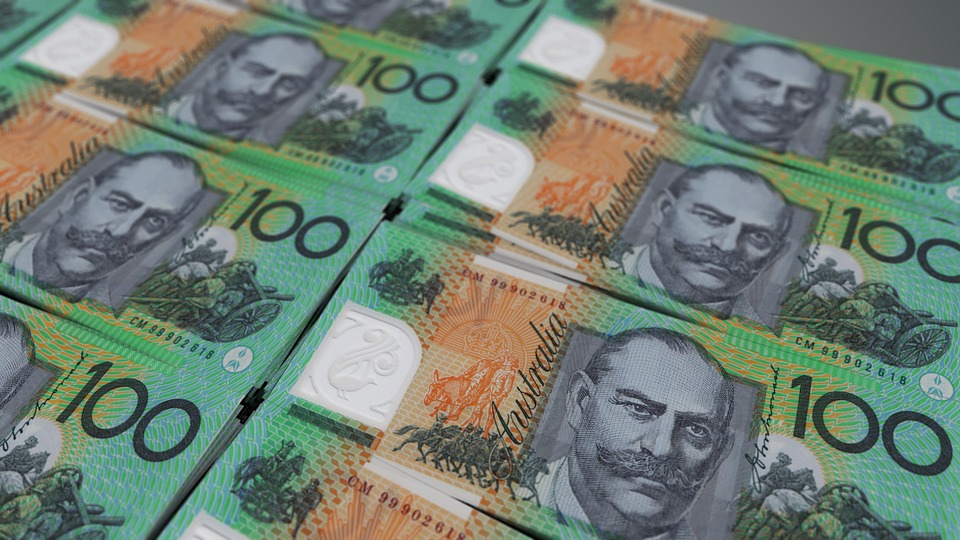 The global economic downturn is beginning to be felt more and more by the Australian working class in the form of a cost-of-living crisis / Image: public domain
The global economic downturn is beginning to be felt more and more by the Australian working class in the form of a cost-of-living crisis / Image: public domain
However, Australia experienced an overall malaise rather than a particularly sharp slump. At some point, quantity will turn into quality and a hard landing awaits. The Australian economy is both highly reliant on exports to China and also an ally of the United States. The country is therefore coming under increasing pressure due to the increasing tensions between these two countries.
Australia has already entered the first stage of this slump. The global economic downturn is beginning to be felt more and more by the Australian working class in the form of a cost-of-living crisis. Quite simply, wages are not keeping up with inflationary pressures, leading to a relative decline in living standards and increasing household debt burden. On top of this, you see endemic problems with housing shortages, poor infrastructure and services in working-class suburbs, increasing poverty levels and now a burgeoning national debt crisis due to the various ‘stimulus’ measures enacted during the pandemic.
Blairism: Australian style
After the election was called, things got off to a rough start for Labor in the first week of the campaign. The Labor leader, Anthony Albanese, was raked over the coals due to a gaffe over not knowing the current unemployment rate, or the Reserve Bank’s current cash rate. This wouldn’t have been much of an issue if the ALP had some sort of programme in the interests of the working class, but without this, these silly ‘gotcha’ questions made him look like a fool and took the wind out of his sails.
Although much was made of Albanese’s working-class background, the ALP overall ran a pretty insipid campaign along similar lines to the failed 2019 one. Desperate to avoid looking too ‘radical’, and to present themselves as ‘sensible’ managers of the capitalist system to the ruling class, they carried out a so-called ‘small target’ strategy of promising very little.
Even during the campaign, Albanese at first indicated he would push through a 5.1 percent pay rise, then backpedaled and stated it wasn’t a given. Aside from this, the party focused all its attention on attempting to turn the election into a referendum on the hated Scott Morrison. This ultimately meant that there was very little enthusiasm for the Labor Party. In fact, they actually got less votes in 2022 compared to when they lost the election in 2019. Rather than the Labor Party winning the election, what we really see was the complete rejection of the Coalition.
Polarisation reflected in the polls
Now that the results are (almost entirely) in, we can see how this crisis is being reflected on the political plane. Only two-thirds of voters cast their ballots in favour of the two historic major parties. Labor is coming to power with just 33 percent of the primary vote. This is almost record low levels of support, and approaching the level seen when Scullin was Labor leader during the first years of the Great Depression. They’ve actually stumbled into office this time, on the basis of second preferences, despite a 0.6 percent swing against them on first preferences compared to the last election!
But for the Liberals, this was a catastrophe. Their primary vote has dropped to just 36 percent. Morrison and the Liberal leadership have taken them so far to the right that they have now lost former stronghold seats to a growing independent movement, including the seat of Kooyong, held by Treasurer and Deputy Liberal Leader Josh Frydenberg and one of the wealthiest electorates in the country.
This reflects historic levels of disillusionment with both major parties who have alienated their respective support bases to the point where they are now seeking out alternatives. However, this has not led to a huge growth of far-right populist formations, as some pundits expected. This is despite a colossal amount of cash (A$100 million) thrown at the campaign by billionaire Clive Palmer and his United Australia Party. Compared to their expectations, One Nation, UAP, and Katter’s Party flopped. Pauline Hanson’s One Nation marginally increased its vote (2 percent), but this had more to do with flooding the various electorates with candidates where they had never run before.
Mood for change
The two biggest winners of the election have been the Greens and a growing independent movement, generally defined as the ‘Teals’. Both groups have benefitted from the collapsing authority of the traditional major parties as they drift further from their traditional support base.
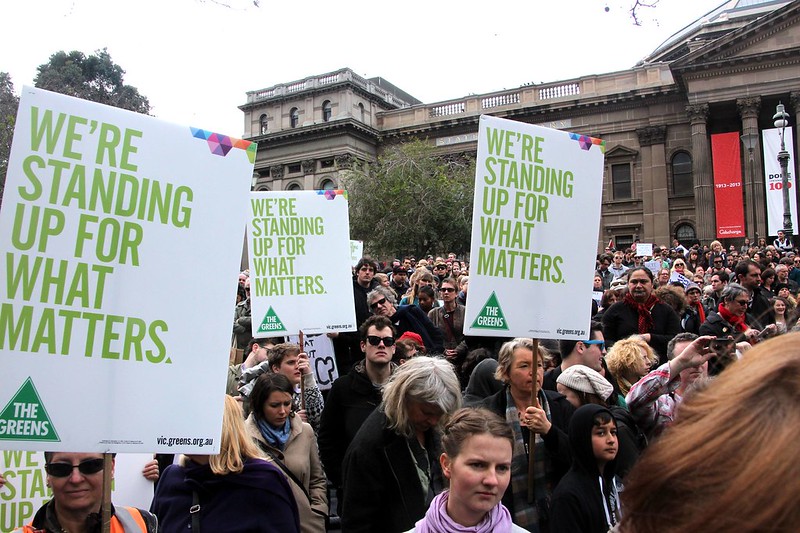 The two biggest winners of the election have been the Greens and a growing independent movement, generally defined as the ‘Teals’ / Image: John Englart Flickr
The two biggest winners of the election have been the Greens and a growing independent movement, generally defined as the ‘Teals’ / Image: John Englart Flickr
The so-called Teals, teal chosen as it combines conservative blue with environmental green, broke through in this election and have picked up seats in historic Liberal strongholds. It’s not a formal political party but is primarily composed of what in the past would have been termed ‘wet’ (moderate) Liberals vs the ‘dry’ Liberals, who have taken the Liberal Party sharply to the right. In doing so they’ve purged the wets from senior positions and candidacy through various factional manoeuvres. Partially funded by ‘Climate 200’, the billionaire Simon Holmes à Court’s political fundraising group, it's an unstable and loose formation. The only thing that really unites the Teal independents is seeking more action on climate change, disillusionment with the Liberal Party as well as their obvious misogyny and bigotry, and unflinching contempt for the working class.
There’s a possibility the Teal phenomenon will be reabsorbed into the Liberal Party at some point, but considering the Liberals’ present character it can’t be ruled out they may evolve into an actual political party. Their existence really depends on developments with the Liberal Party and how the economic crisis continues to unfold. The petty-bourgeois layers supporting the Teals have been nicely fattened up over the past period and aren’t going to accept a tightening of their belts. They’ll also be very quick to abandon their little project and reunite with the Liberal Party in some way if forced into a confrontation with the working class, as they will instinctively defend their own class interests and the capitalist system that underpins it.
The biggest winners on the left of politics have been the Greens, with their best election result since the party’s formation. Regrouping over the past period after getting their fingers burnt due to their involvement in the Gillard-led Labor government, they’ve firmly positioned themselves on the left flank of the ALP. Most of their economic policies were taken straight from the Labor left songsheet of old. As always the case with Green parties everywhere, the closer they get to power, the quicker they abandon any of these ideas, including their ‘green’ agenda. Yet these results are still a reflection of them attracting individuals who are shifting to the left in the major urban areas.
Capitalist reality bites
Undoubtedly, climate change resonates on both sides of the political divide. The issue is becoming a touchstone issue for the youth. Capitalism is killing the planet. The sense of urgency is becoming more apparent as heatwaves intensify and bushfires ravage the country. The two groups that broke through this election have put climate change front and centre, which has clearly resonated with wide layers. Yet it is the capitalist system that is destroying the planet, and none of the political groups currently sitting in parliament have any intention of confronting it.
The result of the election has shown a growing section of the public is looking for change. As the economic crisis intensifies, the Labor government under Albanese will not hesitate to make the workers pay for the crisis. We say that the capitalists, not the working class, must pay for this crisis.
The global economic pattern of cuts and crises that Australia has been able to avoid over the past period is now looming. This means savage attacks in the name of ‘austerity’, as the capitalists seek to make the working class pay for the crisis. However, this is a finished recipe for class struggle. There will be upheavals and social conflict as the political situation polarises further, and the economic problems intensify.
Only the power of the working class, organised around a clear socialist programme, can put an end to the crisis and transform society. We need to build, organise and develop the necessary forces to achieve this.

